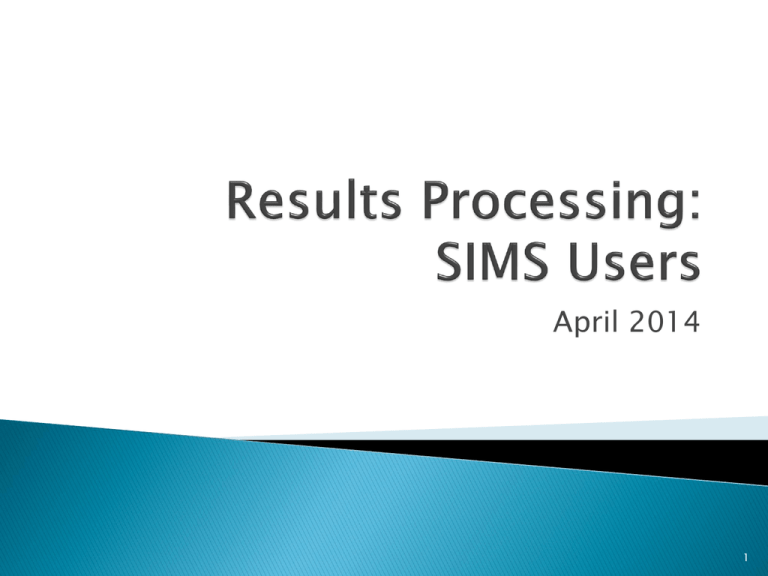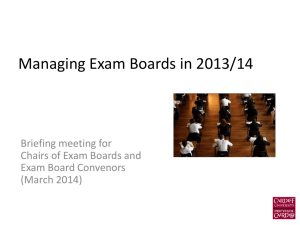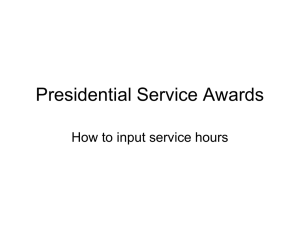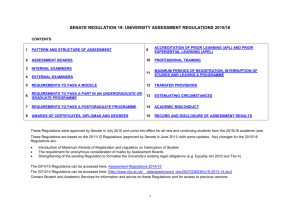Processing Results 2014 Training - Student Experience & Academic
advertisement

April 2014 1 Plan Section 1 Entering and calculating marks Section 2 Running exam board reports Break Section 3 Unfair practice, discounting, secondary rules, any other business 2 Section 1 Enter marks Enter all component marks Throughout year Calculate marks Calculate overall module mark (includes capping/extenuating circumstances information Before running Examining Board reports (deadline agreed with Student Records) Award and Progression Rules Student records will calculate PROVISIONAL year result Ideally a couple of days before Examining Boards 3 Print Examining Board reports Identify cases that require action Post Exam Board Business Objects (SIMS Exam Board Reporting / Assessment Matters) Any Extenuating Circumstances Missing marks Send annotated schedule and paperwork to Student Records Export to Excel or as PDF Ensure amendments are annotated on results schedule Day after Exam Board 4 Via SIMS Online All marks must be calculated before Examining Board reports can be generated for the Board Final date for inputting to be agreed but we suggest 3 days before Board meets so you have chance to check report (some schools like longer, some like less. If you are running on the day of board, ring us to run rules) 5 P Pass PM Pass Module F Fail PX* Student has withdrawn PC* X No submission or absent PD* Pass Module but this module could be eligible for discounting in the final award classification Pass module following condonement This grade will show on any modules ‘condoned’ before 2013/4 session A Student has had extenuating circumstances accepted and no remedy has been possible before the Exam Board FR/AR Resit assessments in the resit period before the start of the next academic session B* Student has had extenuating circumstances accepted relating to a protected characteristic FE/AE Resit assessments in the following academic session UP* An allegation of unfair practice is being investigated. FI/AI Retake module as an internal student in the following academic session UA* Following investigation into an allegation of unfair practice, the mark for this assessment has been set to zero UM* Following investigation into an allegation of unfair practice, the mark for this module has been set to zero XW* Student is required to withdraw from module (either FW/AW because they have had the maximum number of attempts or the module will no longer be available QR* QE* I* Student is on interruption of study or module needs to be closed down QI* QW* * NEW FOR SESSION 2013/4 II* Module failed due to failing an assessment with a qualifying mark. Resit assessments in the resit period before the start of the next academic session. Module failed due to failing an assessment with a qualifying mark. Resit assessments in the following academic session. Module failed due to failing an assessment with a qualifying mark. Retake module as an internal student in the following academic session. Module failed due to failing an assessment with a qualifying mark. Student is required to withdraw from module. Student is on interruption of study or module needs to be closed down 6 NB: PGT codes will be prefixed by PG- and UG codes will be prefixed by UGPP Pass Progress PC Progress and carry Module(s) PA Pass Award PS Pass Subsidiary Award PT Pass Transfer CN Continue studying (used for part time) CC Course Complete NN Resit in current year NR Resit in Following Year NW Required to Withdraw RN Resubmit Dissertation (non-submission) RR Resubmit Dissertation AB On Interruption of Study (not prefixed with PG- or UG-) WD Withdrawn (not prefixed with PG- or UG-) UP Unfair Practice – Awaiting outcome of investigation into allegation of unfair practice IC* Institutional credit – used on block 1 only (subsequent blocks where the student failed to achieve the necessary credit would exit with a year result of PS) Other codes you may see NP* Obtained enough credits to progress, but has outstanding modules that need to be resat NH* Decision required by exam board, eg a module has a *W code but is not a required module or a final attempt RV* Review required, eg modules not calculated * NEW FOR SESSION 2013/4 7 Student Records will run the Progression and Award rules against your Programmes on the day agreed. You will receive an email when this has been done confirming you can now run your reports. Using the Exam Board code to generate your Business Objects report will let you group similar courses together 8 Go into ‘Assessment Management’ tab in SIMS Online Reports are found here 9 Module Results – Calculated and Not calculated 10 You will not be able to run your exam board report withouth an exam board 11 The progression set and award classification method have been added to existing tasks in SIMS Online Go to ‘Reports for Staff’ Progression and classification information have been added to these tasks 12 Checking your progression set and award classification method On ‘Programme Information’ tasks: On ‘List of Programmes in a School’ task: 13 Section 2 Two main types of reports (one for Modules and one for Programmes) for use in Board but supporting reports available to help prepare for and support Board Several formats – choose the one that suits your Board (or different versions for different roles) Save as PDF or Excel Go to https://borep.cf.ac.uk Why not consider Booking on a Business Objects training course to see whether you are using all the current functionality? Normally one course run each month http://www.cardiff.ac.uk/insrv/businessobjectsonline/training. html 14 Preferences: Under ‘General’, set ‘Document Viewing’ to “In multiple fullscreen browser windows, one window for each document” Under ‘Web Intelligence’, set ‘When viewing a document’ to “Use my preferred viewing locale to format the data” 15 Report name When used How used Report 1 – Module Results by Module (UG and PG). Module boards Used for Module Boards Report 2A – Summary Report Main board Recommended that ‘Detailed’ tab is returned to Student Records post-board Report 2B – Full Report Main board Can return this report to Student Records post-board Report 3- Extenuating Circumstances, Final Year Fails and Discounting Pre-board To help you prepare pre-board Report 4 – Quality and Standards Main board statistical information Report 5 – Transitional Students Pre-board to provide you with module information for those students who you will need to consider against the old rules 16 Reports will be found under ‘Assessment Matters – University Exam Board Reports’ Report 2A ‘Detailed’ tab or Report 2A is the preferred report for returning confirmed results to Student Records Use this folder No longer used 17 Report 1: Module Results by Module (UG and PG) Key points: All prompt fields must be entered in uppercase letters The ‘wildcard’ (%) can be used in all prompts, except the ‘optional’ prompts which can be left blank; The ‘Enter Assessment Date From’ will bring back all modules calculated after the date entered; Choosing ‘View’ – ‘Draft Mode’ will show all results on one page Choosing ‘Save to my computer as’ saves all tabs on the report; Choosing ‘Save report to my computer as’ just saves the current tab ‘Statistics’ tab gives data at module level for the past 5 years on: • Mean • Median • Highest • Lowest • Standard deviation • No of students (excludings students with mark of zero) • No of students with zero mark 18 Results sorted from highest to lowest Components with a qualifying mark indicated with Q Student names hidden Ext circs at component level shown Zero module marks excluded from stats Resits shown in section below – after the summer this component will be populated 19 Report 2A: Exam Board Summary Report Key points: Exam Board Code MUST be entered; The ‘Academic Year’ shows the student’s information at that point; The ‘Enter Assessment Date From’ will bring back all modules calculated after the date entered (NB this is important because the credit count will be dependent on how many modules are retrieved); ‘Spreadsheet list by Student’ brings back all students on that exam board code, and does not display module selection status. This report would be useful where students across programmes are evaluated together; Year result is not shown for final years, only award mark. The statistics tab displays classification information for the programme(s) for the past 5 years; The ‘code reference’ tab gives a description of the assessment, module and year result codes 20 Report 2A: Spreadsheet List by Programme Exam board code will be displayed Progression rule will be displayed Selection status will be displayed on Spreadsheet List by Programme tab (not by Student tab) Year average (excluding exempt credits) will be displayed Indication of ext circs Indication of discounting Student names hidden Withdrawn student – no year average created Student with credit exemptions – no average calculated 21 Report 2A: Detailed (this is the report you will return to Registry) Academic Year: 2013/4 Name hidden Year module was taken Semester and module selection status Any module grade other than PM will show after the mark. Attempt number greater than 1 will show in brackets after the mark 22 Key points: The Full report allows you to look at modules from past academic years; The ‘+ Assessment’ tab allows you to see all the assessments the student has done on that module; The assessment information indicates any qualifying marks, and indicates where ext circs have applied; The first sits are in the top grid, and the subsequent sits are in the ‘Reassessments’ grid below; The Full report provides tutor information 23 Report 2B: Full Report – Modules and Assessments First sit assessments shown in top grid Indication of ext circs and any qualifying marks Progression and award information UG-PP Resit assessments shown in bottom grid 24 This report is designed to help you prepare for the exam board. It reports: • Modules with extenuating circumstances where the student has a choice to resit or the exam board has to take action • Failed modules where the student is in their final year (to help decide whether the student should resit or not) • Final year module information where the student has either had discounting applied, or where no discounting has been applied but there are modules affected by extenuating circumstances. This report will help you decide if the best degree outcome has been given. 25 Where a student has failed a module and has approved extenuating circumstances on at least one component, a mark of AR (or AE or AW) will have been calculated (unless a component with a qualifying mark has been failed, when the grade will be QR/QE/QW). Where a student has passed a module, the result will show as PX. Use Report 3 to identify these students. 26 Identifying where the student has a choice to resit a passed module affected by extenuating circumstances Module Grade Assessment grade Outcome PX At least one B Student has choice to resit assessment(s) affected by Extenuating Circumstances relating to protected characteristics. A report will identify these. PX At least one A where the assessment has been passed Student has to accept pass, but Module potentially eligible for discounting at classification stage PX At least one A where the assessment has been failed Student has choice to resit failed assessment(s) affected by Extenuating Circumstances 27 Report 3: Extenuating Circumstances tab Student has choice to resit as ‘B’ code Only applicable for Schools with modules which have qualifying marks Student has choice to resit as component with ext circs was failed Ext circs on component with Q mark – student to resit as 1st attempt component with Q mark was failed with NO ext circs – student to resit as 2nd attempt 28 Report 3: Final Year fails tab 29 The below grid can help the board to decide whether it is worth the student retaking failed modules 40:60 weighting Year contributes 40% Year contributes 60% Module credits For each 10 marks Final mark changes by: Final mark changes by: 10 10 marks 0.333 0.500 20 10 marks 0.667 1.000 30 10 marks 1.000 1.500 40 10 marks 1.333 2.000 30:70 weighting Year contributes 30% Year contributes 70% Module credits For each 10 marks Final mark changes by: Final mark changes by: 10 10 marks 0.250 0.583 20 10 marks 0.500 1.167 30 10 marks 0.750 1.750 40 10 marks 1.000 2.333 30 Extenuating Circumstances (discounting) SIMS will calculate both: ◦ A student’s final mark with no discounting; and ◦ A student’s final mark with the lowest module marks (up to 1/6 of the contributing credit) discounted; i.e. with the marks of modules impacted by extenuating circumstances removed from the calculation. SIMS will choose the best out of the two marks and will use this to give the provisional classification of the student’s award. 31 Manual discounting Boards may wish to consider checking whether SIMS has calculated the best possible outcome for the student where: ◦ students have modules impacted by extenuating circumstances in different years (given these will have different weightings); ◦ where the results of the eligible modules for discounting include some results above the student’s final mark. Use the flow chart in Appendix A to help make manual discounting decisions 32 Report 3: Discounting tab Report will show details for final years where award has been discounted, and where discounting has not been applied but degree affected by extenuating circumstances Discounting applied 30% 70% Modules affected by ext circs 33 There will be a report providing statistical information for your programme for the past 5 academic years 34 • Transitional students are those students who studied assessments contributing to their award in 2011/2 or earlier • You have been asked to confirm your transitional students to us • You can use wildcards (%) on all prompts apart from exam board code, which is required information • The report will bring back the following information for all the students you’ve identified to us as transitional, so you can calculate results by your previous rules and compare outcomes * Criteria used: exam board code = UFPSYCH 35 Section 3 Students where SIMS has been unable to calculate a result – look for blanks in the year result. This will usually be because there are missing marks, either because you haven’t calculated the module mark or they haven’t been given to you for inputting yet. If it is for a small number and it is a Progression rather than an Award Board, annotate at Board. Large numbers or it is for an Award, update asap and phone Student Records to have rules re-run. 36 An students with an outstanding allegation of Unfair Practice will have a module grade of UP, and a year result of UG-UP Outcomes need to be known before result can be issued to student. Once you know the result, enter the final mark and grade and calculate the module result. Contact Student Records to have the year result calculated for the student. Once Exam Board has confirmed result, send the schedule for that student to Student Records 37 The Chair of the Exam Board or nominee must complete the Pro-Forma Change of Examination Results and return to Student Records. All Change of Exam Results have to be approved by executive action of the Chair of the Academic Standards & Quality Committee. However, please note that changes which arise from extenuating circumstances must be administered under the Verification and Appeals procedure. 38 Calculated when the progression and award rules are run; Modules condoned this session onwards will have module grade of PC (modules which were ‘condoned’ in previous sessions will be identified via a grade of PD, and won’t count towards the condonement limits as stated in the Senate Regulations); Automatic condonement will only be applied where it would enable a student to progress; It will not therefore be applied to any student who has grades of AR or AE in the period of study that is being considered for condonement. For full condonement criteria, please see Senate Regulations for Taught Modular Programmes – undergraduate and postgraduate 39 change marks, apart from in exceptional circumstances: • When defects or irregularities in the conduct of the examinations (e.g. error on a question paper) are identified; • When the External Examiners determine that the marking is out-of-line with expected standards; • In disciplines where ‘scaling’ is used as part of the agreed assessment strategy. discuss the details of unfair practice cases - only the chair should be aware of allegations or penalties; use discretion, even if applying the ‘old’ rules 40 You will be able to see if the final mark used to classify the degree has been upgraded as there will be a ‘Y’ in the ‘secondary rule applied’ box in report 2A detail, report 2B and report 3 Example: upgrade to a First Class Honours on a 3 year degree: final mark of 68% or 69%; Module mark of 70% or more in modules at level 5 and 6 to the value of at least 120 credits; At least 60 of these credits achieved at level 6 41 “For the purposes of classification, ALL Modules pursued at Level 5 and Level 6 and, where appropriate, Level 7 will be combined according to the weighting adopted … to provide a Final Mark.” (i.e. it is not the best 120 credits, it is all credits taken at a contributing level – so if a student replaced a failed level 4 module with a level 5 module, that mark will contribute to classification.) 42 Once the Exam Board has met, Schools have to submit the following to Student Records: Hard copy of the Results Schedule (Report 2A Detail OR Report 2B) with handwritten annotations showing Exam Board amendments and signed by Chair Awards and Progress Committee Pro-Forma Examining Board Checklist. 43 School number 79555 Back-up 79204 Alternative numbers will be given in email confirming the Award and Progression rules have been run 44 Appendix A 3.3 Discounting: process map (i.e. where a student has modules impacted by Extenuating Circumstances that can be removed from the calculation used to classify an award) Where a student is eligible for an award, but has passed a module(s) that has been affected by Extenuating Circumstances, the Board may remove affected (up to one sixth of the contributing) credits from the calculation that determines the classification of that award (discounting); provided that a sufficient remedy has not been applied previously. A Board may also discount failed credit that has been affected by Extenuating Circumstances, provided the student has achieved sufficient credit to be eligible for that award. The Board shall discount module(s) from this calculation, only where it benefits the student. Are all the module marks awarded in the impacted modules greater than or equal to the student’s ‘Final Mark’? The ‘Final Mark’ recorded in SIMS will give the student the best outcome YES NO Confirm the mark and award using the mark recorded in SIMS. Identify the modules that, if discounted, would have the most beneficial impact on the student’s final mark, and re-calculate the final award (i.e. taking account of the weightings that apply to different years), by removing these modules from the award calculation. Annotate the revised ‘Final Mark’ on the Exam Board Report prior to the meeting, noting the modules that should be discounted. The ‘Final Mark’ recorded in SIMS MAY NOT give the student the best possible outcome Is the revised ‘Final Mark’ now within 2% of the higher classification band? YES Where applicable, (i.e. in Undergraduate programmes) apply the ‘Secondary Rule’ to identify if the student’s classification will be raised to the higher band. NO Confirm the revised ‘Final Mark’ and classification to be given to the student’s award on the report at the Exam Board meeting. 45 Appendix B Checklist Pre-board – please ensure that you have: • Calculated all your module results • Run the business objects reports • Ensured that any students with extenuating circumstances where the exam board has to intervene have been identified • Ensured any discounting scenarios needing checking have been done Post-board – please ensure that you have: • Returned a handwritten annotated copy of the report, signed by the Chair of Exam Board • Returned the awards and progress committee pro-forma • Returned the examining board checklist 46








